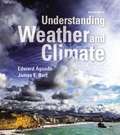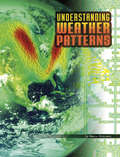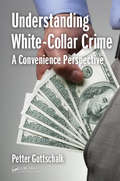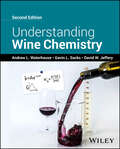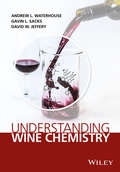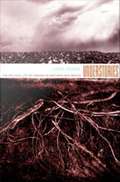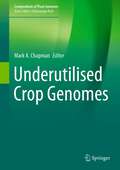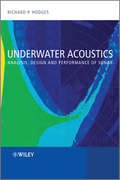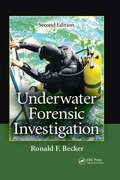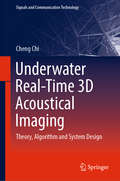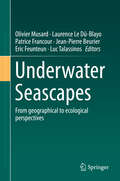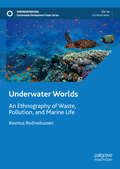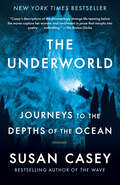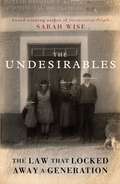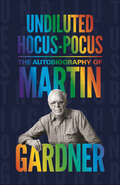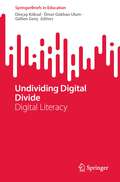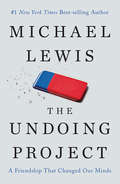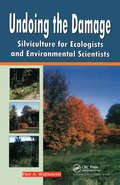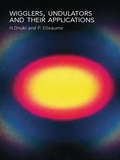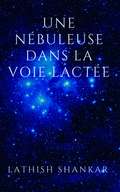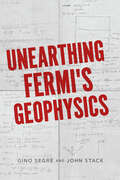- Table View
- List View
Understanding Weather and Climate, Seventh Edition
by Edward Aguado James E. BurtUnderstanding Weather and Climate illustrates meteorology and climatology using everyday occurrences and inspired technology tutorials to engage students in learning about atmospheric processes and patterns. The Seventh Edition extends coverage of global climate change with new and unique sections covering oceans and climate in the Earth system. Each chapter also focuses on the human aspect of weather and climate, covering high interest weather-related hazards that draw students into the course, while incorporating the latest science and the most relevant issues.
Understanding Weather and Climate, Student Guide
by National Science Resources Center Amy Charles John NortonNIMAC-sourced textbook
Understanding Weather Patterns (Discover Meteorology)
by Nancy DickmannWeather is always changing. It can be unpredictable. But even with all the changes, some patterns can be found. Learn how meteorologists use tools and systems to measure and predict these patterns. Find out how these patterns influence weather around the world.
Understanding White-Collar Crime: A Convenience Perspective
by Petter GottschalkUnderstanding White-Collar Crime develops the concept of convenience as the main explanation for crime occurrence. Examining all three dimensions of crime—economic, organizational, and behavioral—the book argues that when white-collar crime becomes less convenient, crime rates will go down. By applying convenience theory to an empirical sample of convicted white-collar criminals, the text teaches criminal justice students and ethics and compliance practitioners to identify and understand how opportunity affects real-world criminal situations. Internal investigations of white-collar crime are discussed, and corporate social responsibility against white-collar crime is emphasized. Understanding White-Collar Crime: A Convenience Perspective examines not only the theories behind white-collar crime, but also explores methods used in criminal justice investigations into corporate fraud, and emphasizes the importance of corporate social responsibility in reducing crimes of this nature. Criminal justice students and practitioners should not miss this close look into the world of white-collar crime.
Understanding Wine Chemistry (Sci (society Of Chemical Industry) Ser.)
by David W. Jeffery Andrew L. Waterhouse Gavin L. SacksUnderstanding Wine Chemistry Understand the reactions behind the world’s most alluring beverages The immense variety of wines on the market is the product of multiple chemical processes – whether acting on components arising in the vineyard, during fermentation, or throughout storage. Winemaking decisions alter the chemistry of finished wines, affecting the flavor, color, stability, and other aspects of the final product. Knowledge of these chemical and biochemical processes is integral to the art and science of winemaking. Understanding Wine Chemistry has served as the definitive introduction to the chemical components of wine, their properties, and their reaction mechanisms. It equips the knowledgeable reader to interpret and predict the outcomes of physicochemical reactions involved with winemaking processes. Now updated to reflect recent research findings, most notably in relation to wine redox chemistry, along with new Special Topics chapters on emerging areas, it continues to set the standard in the subject. Readers of the second edition of Understanding Wine Chemistry will also find: Case studies throughout showing chemistry at work in creating different wine styles and avoiding common adverse chemical and sensory outcomes Detailed treatment of novel subjects like non-alcoholic wines, non-glass alternatives to wine packaging, synthetic wines, and more An authorial team with decades of combined experience in wine chemistry research and education Understanding Wine Chemistry is ideal for college and university students, winemakers at any stage in their practice, professionals in related fields such as suppliers or sommeliers, and chemists with an interest in wine.
Understanding Wine Chemistry
by Gavin L. Sacks Andrew L. Waterhouse David W. JefferyWine chemistry inspires and challenges with its complexity, and while this is intriguing, it can also be a barrier to further understanding. The topic is demystified in Understanding Wine Chemistry, which explains the important chemistry of wine at the level of university education, and provides an accessible reference text for scientists and scientifically trained winemakers alike. Understanding Wine Chemistry: Summarizes the compounds found in wine, their basic chemical properties and their contribution to wine stability and sensory properties Focuses on chemical and biochemical reaction mechanisms that are critical to wine production processes such as fermentation, aging, physiochemical separations and additions Includes case studies showing how chemistry can be harnessed to enhance wine color, aroma, flavor, balance, stability and quality. This descriptive text provides an overview of wine components and explains the key chemical reactions they undergo, such as those controlling the transformation of grape components, those that arise during fermentation, and the evolution of wine flavor and color. The book aims to guide the reader, who perhaps only has a basic knowledge of chemistry, to rationally explain or predict the outcomes of chemical reactions that contribute to the diversity observed among wines. This will help students, winemakers and other interested individuals to anticipate the effects of wine treatments and processes, or interpret experimental results based on an understanding of the major chemical reactions that can occur in wine.
Understories: The Political Life of Forests in Northern New Mexico
by Jake KosekThrough lively, engaging narrative, Understories demonstrates how volatile politics of race, class, and nation animate the notoriously violent struggles over forests in the southwestern United States. Rather than reproduce traditional understandings of nature and environment, Jake Kosek shifts the focus toward material and symbolic "natures," seemingly unchangeable essences central to formations of race, class, and nation that are being remade not just through conflicts over resources but also through everyday practices by Chicano activists, white environmentalists, and state officials as well as nuclear scientists, heroin addicts, and health workers. Drawing on two years of ethnographic fieldwork and extensive archival research, he shows how these contentious natures are integral both to environmental politics and the formation of racialized citizens, politicized landscapes, and modern regimes of rule. Kosek traces the histories of forest extraction and labor exploitation in northern New Mexico, where Hispano residents have forged passionate attachments to place. He describes how their sentiments of dispossession emerged through land tenure systems and federal management programs that remade forest landscapes as exclusionary sites of national and racial purity. Fusing fine-grained ethnography with insights gleaned from cultural studies and science studies, Kosek shows how the nationally beloved Smokey the Bear became a symbol of white racist colonialism for many Hispanos in the region, while Los Alamos National Laboratory, at once revered and reviled, remade regional ecologies and economies. Understories offers an innovative vision of environmental politics, one that challenges scholars as well as activists to radically rework their understandings of relations between nature, justice, and identity.
Underutilised Crop Genomes (Compendium of Plant Genomes)
by Mark A. ChapmanThis book highlights the uses for underutilized crops, presenting the state-of-the-art in terms of genome sequencing for over 30 crops, previously understudied and under-researched. In a changing climate and with significant pressure on the land, it is the ideal time to be discussing novel crops, with significant biotic and abiotic tolerances and/or rich nutrient profiles for consumers. Previously, the only species with sequenced genomes were high-profile internationally recognized crops, but in the current era genomes are being sequenced for dozens of crops, including those previously classified as underutilized, now being investigated. This book covers food crops, from fruits to tubers, and from grasses to legumes, as well as crops with non-food applications. Some of these crops have draft genomes, and others have polished genomes with extensive resequencing panels. Each chapter tells the story of an individual crop or crop group, written by experts, focusing on the genome data available, revealing more about crop domestication and genetic variation, and the current and future prospects given that this data is now becoming available. It also highlights how even small sequencing projects can provide draft genome sequences suitable for gene discovery, comparative genomics, and identification of molecular markers for understanding these crops further.
Underwater Acoustics
by Richard P. HodgesOffering complete and comprehensive coverage of modern sonar spectrum system analysis, Underwater Acoustics: Analysis, Design and Performance of Sonar provides a state-of-the-art introduction to the subject and has been carefully structured to offer a much-needed update to the classic text by Urick. Expanded to included computational approaches to the topic, this book treads the line between the highly theoretical and mathematical texts and the more populist, non-mathematical books that characterize the existing literature in the field. The author compares and contrasts different techniques for sonar design, analysis and performance prediction and includes key experimental and theoretical results, pointing the reader towards further detail with extensive references. Practitioners in the field of sonar design, analysis and performance prediction as well as graduate students and researchers will appreciate this new reference as an invaluable and timely contribution to the field.Chapters include the sonar equation, radiated, self and ambient noise, active sonar sources, transmission loss, reverberation, transducers, active target strength, statistical detection theory, false alarms, contacts and targets, variability and uncertainty, modelling detections and tactical decision aids, cumulative probability of detection, tracking target motion analysis and localization, and design and evaluation of sonars
Underwater California
by Wheeler NorthThis guide describes the living creatures of underwater California.
Underwater Forensic Investigation
by Ronald F. Becker Stuart H. Nordby Jon J.The evidence discovered at underwater crime scenes must be handled with the same attention to proper chain of custody procedures as with any other type of investigation. Improper handling of these scenes can lead to evidence being lost, unrecognizable, destroyed, contaminated, or rendered inadmissible at the time of trial. Updated and expanded, Und
Underwater Real-Time 3D Acoustical Imaging: Theory, Algorithm and System Design (Signals and Communication Technology)
by Cheng ChiThis book presents the topic of underwater real-time 3-D acoustical imaging covering the theory, algorithms and system design. It summarizes recent advances in wideband and ultra-wideband underwater real-time 3-D acoustical imaging, which will be very useful for developing next-generation systems. Through simulation techniques, readers are able to quickly learn and develop practical underwater real-time 3-D acoustical imaging systems of their own.
Underwater Seascapes
by Olivier Musard Laurence Le Dû-Blayo Patrice Francour Jean-Pierre Beurier Eric Feunteun Luc TalassinosWhile the European Landscape Convention adopted in Florence in 2000 by the European Council offers a public-action framework through a normative definition, the marine and submarine dimensions of landscapes are attracting growing interest from researchers worldwide. At a time when marine-conservation objectives are strongly endorsed by the Convention on Biological Diversity, the French Marine Protected Areas Agency, a public institution under the governance of the French Ministry of the Environment, has gathered prominent experts to draft the very first interdisciplinary overview of underwater seascapes, so as to initiate and lend direction to a wider reflection on this emerging research topic.
Underwater Worlds: An Ethnography of Waste, Pollution, and Marine Life (Sustainable Development Goals Series)
by Rasmus RodineliussenThis book investigates relations between humans, waste, pollution, and marine life. It introduces the concept of Aquabiopolitics as a means to understand how humans govern life in water in order to enrich human life on land. The study focuses on the Baltic Sea and Lake Mälaren, using Stockholm, the capital of Sweden, as the connection point. Throughout the book, the author explores how human practices over time have had devastating effects on marine life and continue to have so today. The book engages with the marine world through underwater ethnography to provide a perspective on water from below the surface. In this endeavor, it tracks marine scientists and trash scuba divers who are jointly invested in tracking human maltreatment of water and finding solutions for treating water differently in the future. It follows the scientists on expeditions at sea and to their laboratories in order to learn about their methods and relations to underwater worlds. Together with the trash scuba divers, we will dive into the dark murky waters around Stockholm—experiencing what it is like to move below water, among sharp and toxic waste, without any visibility. The work of creating a knowing and caring relationship between humans and water is of key importance to both scientists and divers. Therefore, one of the main parts of this book is to analyze how, and if, this relationship can be created: via social media, images, installations, or other means.
The Underworld: Journeys to the Depths of the Ocean
by Susan CaseyNEW YORK TIMES BESTSELLER • From bestselling author Susan Casey, an awe-inspiring portrait of the mysterious world beneath the waves, and the men and women who seek to uncover its secrets&“An irresistible mix of splendid scholarship, heart-stopping adventure writing, and vivid, visceral prose." —Sy Montgomery, New York Times best-selling author of The Soul of an Octopus For all of human history, the deep ocean has been a source of wonder and terror, an unknown realm that evoked a singular, compelling question: What&’s down there? Unable to answer this for centuries, people believed the deep was a sinister realm of fiendish creatures and deadly peril. But now, cutting-edge technologies allow scientists and explorers to dive miles beneath the surface, and we are beginning to understand this strange and exotic underworld: A place of soaring mountains, smoldering volcanoes, and valleys 7,000 feet deeper than Everest is high, where tectonic plates collide and separate, and extraordinary life forms operate under different rules. Far from a dark void, the deep is a vibrant realm that&’s home to pink gelatinous predators and shimmering creatures a hundred feet long and ancient animals with glass skeletons and sharks that live for half a millennium—among countless other marvels.Susan Casey is our premiere chronicler of the aquatic world. For The Underworld she traversed the globe, joining scientists and explorers on dives to the deepest places on the planet, interviewing the marine geologists, marine biologists, and oceanographers who are searching for knowledge in this vast unseen realm. She takes us on a fascinating journey through the history of deep-sea exploration, from the myths and legends of the ancient world to storied shipwrecks we can now reach on the bottom, to the first intrepid bathysphere pilots, to the scientists who are just beginning to understand the mind-blowing complexity and ecological importance of the quadrillions of creatures who live in realms long thought to be devoid of life.Throughout this journey, she learned how vital the deep is to the future of the planet, and how urgent it is that we understand it in a time of increasing threats from climate change, industrial fishing, pollution, and the mining companies that are also exploring its depths. The Underworld is Susan Casey&’s most beautiful and thrilling book yet, a gorgeous evocation of the natural world and a powerful call to arms.
The Undesirables: The Law that Locked Away a Generation
by Sarah WiseThrough the early twentieth century, the British Government locked away over 50,000 innocent people. Their &‘crimes&’? Being poor and unyielding. This is their story. 'The heartrending stories Sarah Wise has unearthed beggar belief… beautifully researched and truly compelling.' Catherine Bailey, author of Black Diamonds By 1950, an estimated 50,000 people had been deemed &‘defective&’ by the British government and detained indefinitely under the 1913 Mental Deficiency Act. Their &‘crimes&’ were various: women with children born out of wedlock; rebellious teenagers caught shoplifting; those with epilepsy, hearing impairments and chronic illnesses who had struggled in school; and many who were simply &‘different&’. Forcibly removed from their families and confined to a shadow world of specialist facilities in the countryside, they were hidden away and forgotten – out of sight, out of mind. Through painstaking archival research, award-winning historian Sarah Wise shines a light on this shameful chapter. Piecing together the lives irrevocably changed by this devastating legislation, The Undesirables provides a compelling study of how early twentieth-century attitudes to class, gender and disability resulted in a nationwide scandal – and how they continue to shape social policy to this day.
Undiluted Hocus-Pocus: The Autobiography of Martin Gardner
by Martin GardnerThe autobiography of the beloved writer who inspired a generation to study math and scienceMartin Gardner wrote the Mathematical Games column for Scientific American for twenty-five years and published more than seventy books on topics as diverse as magic, religion, and Alice in Wonderland. Gardner's illuminating autobiography is a candid self-portrait by the man evolutionary theorist Stephen Jay Gould called our "single brightest beacon" for the defense of rationality and good science against mysticism and anti-intellectualism.Gardner takes readers from his childhood in Oklahoma to his varied and wide-ranging professional pursuits. He shares colorful anecdotes about the many fascinating people he met and mentored, and voices strong opinions on the subjects that matter to him most, from his love of mathematics to his uncompromising stance against pseudoscience. For Gardner, our mathematically structured universe is undiluted hocus-pocus—a marvelous enigma, in other words.Undiluted Hocus-Pocus offers a rare, intimate look at Gardner’s life and work, and the experiences that shaped both.
Undividing Digital Divide: Digital Literacy (SpringerBriefs in Education)
by Dinçay Köksal Ömer Gökhan Ulum Gülten GençThis book problematizes digital divide with critical lens by focusing on education in general and specifically second language education with an emphasis on the context of Turkey based on sound methodologies and robust theories of modernity, postmodernity, post-structuralism and post-method framework. In line with this conceptualization, critical thinking skills, social dialogue, collaboration, accessibility and digital literacy have been widely discussed empirically and prioritized in this book. In addition, social injustice, digital inequality, gender gap, economic disparity, demographic differences and knowledge divide have also been addressed. EFL teachers and pre-service teachers as cultural workers have been incorporated into the studies to critically reflect upon digital divide in Turkey. The views of teachers and learners at a socio-economic disadvantage emanating from socio-political issues have been addressed and foregrounded. The digital divide and inequalities that COVID-19 pandemic has produced have also been emphasized. The context of Turkey where digital divide has been prevalent during COVID-19 pandemic is believed to inspire researchers specializing in digitalization and digital education. The strategies, problems, effects and solutions have been presented. This book presents a reliable source to students, teachers and academics in education and second language education as well as social scientists and policy-makers across the globe.
The Undoing Project: A Friendship That Changed Our Minds
by Michael Lewis<P>How a Nobel Prize-winning theory of the mind altered our perception of reality. <P>Forty years ago, Israeli psychologists Daniel Kahneman and Amos Tversky wrote a series of breathtakingly original studies undoing our assumptions about the decision-making process. Their papers showed the ways in which the human mind erred, systematically, when forced to make judgments in uncertain situations. Their work created the field of behavioral economics, revolutionized Big Data studies, advanced evidence-based medicine, led to a new approach to government regulation, and made much of Michael Lewis's own work possible. Kahneman and Tversky are more responsible than anybody for the powerful trend to mistrust human intuition and defer to algorithms. <P>The Undoing Project is about a compelling collaboration between two men who have the dimensions of great literary figures. They became heroes in the university and on the battlefield--both had important careers in the Israeli military--and their research was deeply linked to their extraordinary life experiences. Amos Tversky was a brilliant, self-confident warrior and extrovert, the center of rapt attention in any room; Kahneman, a fugitive from the Nazis in his childhood, was an introvert whose questing self-doubt was the seedbed of his ideas. They became one of the greatest partnerships in the history of science, working together so closely that they couldn't remember whose brain originated which ideas, or who should claim credit. They flipped a coin to decide the lead authorship on the first paper they wrote, and simply alternated thereafter. <P>This story about the workings of the human mind is explored through the personalities of two fascinating individuals so fundamentally different from each other that they seem unlikely friends or colleagues. In the process they may well have changed, for good, mankind's view of its own mind. <P><b>A New York Times Bestseller</b>
Undoing the Damage: Silviculture for Ecologists and Environmental Scientists
by P A WojtkowskiAs a natural science, silviculture has a large say in how humans interact with the terrestrial world. Although the perspective taken here that the production of wood is narrow, the amount of land area consumed is extensive; the indirect consequences of wood production on natural processes are larger still. Through the amount of land engaged, the flora and fauna affected and the environmental consequences, good or bad; silviculture is a frequent constituent in applied ecology, environmental science, conservation ecology and other broad land-use disciplines. Silvicultural expertize is essential when trees and wood are an economic output; often best promoted when silviculture is allied with hydrology, ecology, soil science, wildlife management, etc. This book touches upon the following important areas of the subject in detail.
Undulators, Wigglers and Their Applications
by H. Onuki P. ElleaumeA "wiggler" is an insertion device used for spatially concentrating radiation for research purposes, and an "undulator" is a multi-period wiggler. Undulator and wiggler devices are inserted in a free straight section of the storage ring of the synchrotron. This book explores the radiation produced by these insertion devices, the engineering and ass
Une femme en ingénierie: Mémoires d'une pionnière (Biographies et mémoires #25)
by Monique FrizeDans ses mémoires à la fois inspirants et émouvants, l’ingénieure de renommée internationale, Monique Aubry-Frize, O.C., raconte son parcours exceptionnel dans un domaine résolument dominé par les hommes.Très tôt, son but était de devenir une ingénieure biomédicale reconnue afin d’améliorer le statut des femmes en sciences et en génie, ainsi que la manière dont les scientifiques et les ingénieurs intègrent les personnes et la société dans leurs travaux. Dès 1979, son rêve est devenu réalité.Monique Aubry-Frize relate avec lucidité et franchise les événements de sa vie qui lui ont permis de vaincre les nombreux obstacles qui se sont dressés sur sa route, de devenir plus résiliente, et de reconnaître l’importance des mentors et des modèles à suivre. Elle témoigne égalementdu rôle essentiel joué par sa famille et ses amis, qui l’ont soutenue et lui ont donné la force et la détermination nécessaires pour réussir dans un monde majoritairement masculin.L’autrice évoque avec tendresse son enfance à Ottawa et souligne son intérêt précoce pour les mathématiques et les sciences. Son entrée dans le monde de l’ingénierie a été romantique – c’est à la faculté de génie de l’Université d’Ottawa qu’elle a rencontré son premier mari –, mais également tragique. Elle a fait face à maints préjugés et stéréotypes qu’elle est finalement parvenue à surmonter. Elle a réussi à concilier travail et famille, poursuivant une carrière exigeante, mais gratifiante dans un domaine très spécialisé, à une époque où peu de femmes s’y risquaient.Ses mémoires Une femme en ingénierie seront sans aucun doute une source d’inspiration pour les nouvelles générations de femmes qui rêvent d’une carrière en sciences et en génie.
Une nébuleuse dans la Voie Lactée
by Lathish ShankarAmélia est une étudiante sensible aux événements paranormaux. Elle écrit un article pour le journal de l’université, sur lequel elle déclare qu'elle entend des voix venues du futur. Stephen, professeur de physique, lit l’article et en discute avec sa femme Isabella, docteur en psychiatrie. Un jour, Amélia s’évanouit dans la cafétéria pendant que ses amis parlaient des cours de dissections. Isabella, docteur d’Amélia, révèle qu’elle souffre d’une phobie de sang, causée par un évènement traumatisant. Stephen pense être à l’origine de sa peur. Se sentant responsable, il va demander de l’aide à son ami Zachariah John, l’inventeur de la machine à remonter le temps. Zachariah va-t-il aider son ami à remonter le temps ? Stephen va-t-il changer le cours du passé ? Va-t-il guérir Amélia de sa phobie ?
Unearthing Fermi's Geophysics
by Gino C. Segrè John D. StackFollow Nobel laureate and legendary teacher Enrico Fermi’s lost course on geophysics. Nobel Prize–winning physicist Enrico Fermi (1901–54) is known for his work on experimental particle and nuclear physics, quantum theory, and statistical mechanics, and for his particular ability to condense complicated problems into approximations for understanding and testing theory in a variety of scientific disciplines. Six of his graduate students went on to win their own Nobel Prizes. Unearthing Fermi’s Geophysics opens a window onto two underrepresented facets of this extraordinary thinker: Fermi’s teaching and his contribution to the field of geophysics. Drawing on Fermi’s handwritten calculations and notes, many of which are reproduced here in photographic facsimile, physicists Gino Segrè and John Stack have reconstructed a coursebook of Fermi’s insights into the physics of a range of geological and atmospheric phenomena. From gravity on Earth to thermodynamics in the atmosphere, the physics of raindrops, the Coriolis effect in hurricanes, tidal physics, earthquakes and seismic waves, Earth’s magnetism, atmospheric electricity, and much more, Unearthing Fermi’s Geophysics reveals the hidden workings of the world above, around, and below us—and of the mind of a great scientist who was able to bring those physical workings to light.
Unearthing Fermi's Geophysics
by Gino C. Segrè John D. StackFollow Nobel laureate and legendary teacher Enrico Fermi’s lost course on geophysics. Nobel Prize–winning physicist Enrico Fermi (1901–54) is known for his work on experimental particle and nuclear physics, quantum theory, and statistical mechanics, and for his particular ability to condense complicated problems into approximations for understanding and testing theory in a variety of scientific disciplines. Six of his graduate students went on to win their own Nobel Prizes. Unearthing Fermi’s Geophysics opens a window onto two underrepresented facets of this extraordinary thinker: Fermi’s teaching and his contribution to the field of geophysics. Drawing on Fermi’s handwritten calculations and notes, many of which are reproduced here in photographic facsimile, physicists Gino Segrè and John Stack have reconstructed a coursebook of Fermi’s insights into the physics of a range of geological and atmospheric phenomena. From gravity on Earth to thermodynamics in the atmosphere, the physics of raindrops, the Coriolis effect in hurricanes, tidal physics, earthquakes and seismic waves, Earth’s magnetism, atmospheric electricity, and much more, Unearthing Fermi’s Geophysics reveals the hidden workings of the world above, around, and below us—and of the mind of a great scientist who was able to bring those physical workings to light.
